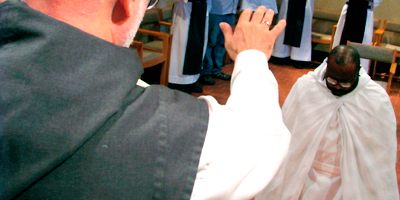
 MONCKS CORNER—The monks at Mepkin Abbey have joined a national movement to educate people about monastic life.
MONCKS CORNER—The monks at Mepkin Abbey have joined a national movement to educate people about monastic life.
Initiated by the Trappists’ Abbey of Gethsemani in Kentucky, the vocations campaign has drawn 16 other communities, including Mepkin.
Father Kevin Walsh, vocations director at the Moncks Corner monastery, makes an important distinction between a vocations effort and vocations awareness. He said the Trappists are not like the military or a sports program actively seeking to recruit people to a monastic life.
“God is the recruiter,” Father Kevin said.
What the Trappist communities hope to do is find the best ways to reach a new generation, because the old ways of disseminating information are no longer viable.
The communities met in March at Holy Spirit Abbey in Conyers, Ga., to coordinate their efforts.
Father Kevin said one of the first things they did was create a website with a map of all the communities in the United States, information about visiting them, writings from “a monk’s diary” and “a nun’s diary,” and a question and answer section (www.trappists.org).
Mepkin also has its own website, www.mepkinabbey.org.
“It’s part of the effort to offer awareness in this new form of electronic media. It’s this whole shift that we’ve all realized is necessary in working with the younger people,” the monk said.
The Trappists are also exploring options through Facebook, Twitter and other social media, and whether those avenues can provide a good spiritual conduit, Father Kevin said.
It’s quite a change from the old days when people were inspired by the spiritual writings of Father Thomas Merton from Gethsemani, he noted.
That was in the 1940s when religious life was booming and Gethsemani had about 250 monks, Father Kevin said.
The monastery expanded across the country, founding Mepkin in 1949, which grew to its heyday of about 50 monks in the late 1950s and early ’60s, he said.
Now they have 18 contemplatives at the monastery and have seen many changes, including a switch from egg production to growing oyster mushrooms and micro greens.
They sell the mushrooms at area Piggly Wiggly stores, but the greens are strictly for restaurants.
“Everything we produce is sold immediately,” Father Kevin said.
The produce business is a way for the monks to help support themselves. He said work is part of the monastic tradition of quietude and prayer that opens one to be closer to God.
He said they spend their days in a rhythm of common and private prayer, like the ebb and flow of tides.
But the monks also have responsibilities and interaction with the public. Father Kevin said it is his role to teach novices how to balance those dual natures, like Martha and Mary.
The Trappists know they have a unique calling.
Father Alberic Farbolin, a monk at the New Melleray Abbey in Peosta, Iowa, is the U.S. regional secretary for formation and vocations.
He said the website and other ideas, such as a DVD, are targeted to those in the discernment process.
“Our goal is not to attract thousands to the website, but to engage that very small group whom God might be calling to live in this very unique and beautiful way,” Father Alberic said in a Catholic News Service article.
Father Kevin said religious life changed after Vatican II, which broadened vocations. Now they are seeing the pendulum swing back, with a revived interest in community and ordained religious life.
The vocations director said the value that youth place on community is something he can use in the discernment process.
Monastic life, by its very nature, will never be a large segment of the population, but it has a distinctive place and distinctive people called by God, he said.
For this reason, he isn’t sure the more public avenues of social media are the right place for discernment, which can be a private process, but said it is worth exploring.
Father Kevin recalled trying to explain to his twin brother, who has since married and had children and grandchildren, why he felt called to a contemplative life of prayer.
His brother thought he was crazy, the monk said, and he admits one gives up much of the outside world to join a monastery. On the other hand, Father Kevin said he has gained a spiritual freedom that allows him to lift his heart and mind to God in a way he couldn’t have done in another ministry.
He said the first step a candidate should make is to come on retreat to the monastery and follow the monks’ schedule of prayer. After a couple of retreats, the person can live in the monastery as an observer for several weeks.
“You have to come and try on the life,” he said. “Leave your cell phone at home.”
Father Kevin said they have had about eight observers in the last couple of years, and three have applied.
“A person who is called by God to this way of life will find themselves really being completed … and doing something that is truly countercultural,” he said.
